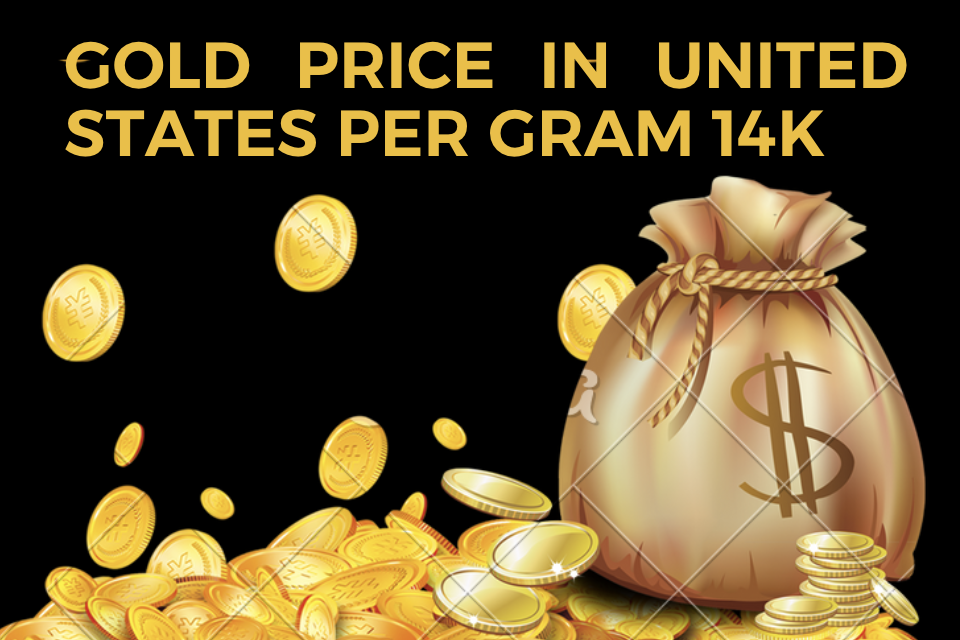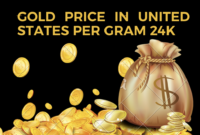Understanding the current gold price is crucial for investors, jewelers, and anyone interested in the value of gold. This article aims to provide a detailed, up-to-date analysis of the gold price per gram for 14K gold in the United States. By keeping track of these changes, you can make informed decisions regarding your gold investments.
Gold Price in United States per Gram 14K = 63.22 USD
Gold Price in United States per Gram 14K – Gold prices fluctuate daily due to various market factors. This section provides the most recent price per gram for 14K gold in the United States. Below, you will find a table showing the 30-day price trend for 14K gold, updated as of 14/07/2025. Below is the 30-day fluctuation data for 14K gold prices per gram. The table reflects the dynamic nature of the gold market, helping you understand how the value of 14K gold has changed over the past month.
| Date | Price (USD) | Change |
|---|---|---|
| 14/07/2025 | 63.22 | +0.86 |
| 11/07/2025 | 62.36 | +0.12 |
| 10/07/2025 | 62.24 | +0.30 |
| 09/07/2025 | 61.94 | -0.72 |
| 08/07/2025 | 62.66 | +0.20 |
| 07/07/2025 | 62.46 | -0.76 |
| 06/06/2025 | 63.22 | -0.02 |
| 05/06/2025 | 63.24 | +0.10 |
| 04/06/2025 | 63.14 | -0.07 |
| 03/06/2025 | 63.21 | +1.13 |
| 02/06/2025 | 62.08 | +0.27 |
| 30/05/2025 | 61.81 | +0.37 |
| 29/05/2025 | 61.44 | -0.43 |
| 28/05/2025 | 61.87 | -0.85 |
| 27/05/2025 | 62.72 | -0.09 |
| 26/05/2025 | 62.81 | +0.93 |
| 23/05/2025 | 61.88 | -0.66 |
| 22/05/2025 | 62.54 | +0.62 |
| 21/05/2025 | 61.92 | +1.66 |
| 20/05/2025 | 60.26 | -0.02 |
| 19/05/2025 | 60.28 | -0.01 |
| 16/05/2025 | 60.29 | +1.13 |
| 15/05/2025 | 59.16 | -1.45 |
| 14/05/2025 | 60.61 | -0.11 |
| 13/05/2025 | 60.72 | -0.82 |
| 12/05/2025 | 61.54 | -0.52 |
| 09/05/2025 | 62.06 | -1.78 |
| 08/05/2025 | 63.84 | +0.44 |
| 07/05/2025 | 63.40 | +0.34 |
| 06/05/2025 | 63.06 | +1.71 |
Gold Price Chart for 14K Gold in the United States in USD
Understanding historical trends is as important as knowing the current price. This section provides a visual representation of the 14K gold price movements in the United States, allowing you to see the bigger picture. The following chart displays the historical price data for 14K gold in the United States, providing a comprehensive view of how prices have evolved over time. This can help you spot trends and make more informed decisions about your gold investments.
Comparison of 14K Gold Prices with 16K and 21K Gold
To give a broader perspective on gold prices, this section compares the price of 14K gold with other gold types, specifically 16K and 21K. Comparing different karats can provide insights into which type of gold might be the best investment. The table below presents a 30-day comparison of 14K, 12K, and 21K gold prices per gram in the United States. Updated as of 14/07/2025, this comparison will help you understand the value differences between these gold types.
| Date | Gram14K | Gram16K | Gram21K |
|---|---|---|---|
| 14/07/2025 | 63.22 | Data tidak tersedia | 94.78 |
| 11/07/2025 | 62.36 | Data tidak tersedia | 93.50 |
| 10/07/2025 | 62.24 | Data tidak tersedia | 93.32 |
| 09/07/2025 | 61.94 | Data tidak tersedia | 92.87 |
| 08/07/2025 | 62.66 | Data tidak tersedia | 93.95 |
| 07/07/2025 | 62.46 | Data tidak tersedia | 93.65 |
| 06/06/2025 | 63.22 | Data tidak tersedia | 94.79 |
| 05/06/2025 | 63.24 | Data tidak tersedia | 94.82 |
| 04/06/2025 | 63.14 | Data tidak tersedia | 94.67 |
| 03/06/2025 | 63.21 | Data tidak tersedia | 94.77 |
| 02/06/2025 | 62.08 | Data tidak tersedia | 93.07 |
| 30/05/2025 | 61.81 | Data tidak tersedia | 92.68 |
| 29/05/2025 | 61.44 | Data tidak tersedia | 92.11 |
| 28/05/2025 | 61.87 | Data tidak tersedia | 92.77 |
| 27/05/2025 | 62.72 | Data tidak tersedia | 94.04 |

Factors Influencing the Daily Gold Price of 14K Gold in the United States
GoldPlush.Com – Gold has long been considered a safe haven for investors, and its price is closely watched around the world. Understanding the factors that influence the daily price of 14K gold in the United States can provide valuable insights for investors, jewelers, and consumers. The price of 14K gold is affected by a myriad of factors, including economic indicators, market demand, geopolitical events, and currency fluctuations.
Economic Indicators
One of the primary factors influencing the price of 14K gold is the state of the global economy. When economic indicators such as GDP growth, employment rates, and inflation suggest a robust economy, the price of gold may decrease as investors feel more confident in riskier assets like stocks. Conversely, when economic indicators point to a slowing economy or potential recession, investors often flock to gold as a safe haven, driving up its price. For example, during times of high inflation, the value of paper currency may decrease, but gold often retains its value, making it an attractive investment.
Market Demand
The demand for gold jewelry, especially in countries with significant cultural attachments to gold, such as India and China, can heavily influence the price of 14K gold. During festive seasons and wedding seasons in these countries, the demand for gold jewelry increases, pushing up prices. Additionally, gold is used in various industrial applications, including electronics and dentistry, which can also impact its price. As technology advances and the use of gold in new applications grows, the demand for gold may rise, leading to higher prices.
Geopolitical Events
Geopolitical stability or instability can significantly impact the price of 14K gold. During times of geopolitical tension, such as wars, political unrest, or international conflicts, investors often seek refuge in safe-haven assets like gold. For instance, the price of gold surged during the Gulf War and the financial crisis of 2008. Conversely, periods of relative geopolitical stability may lead to a decrease in gold prices as investors feel more secure investing in other assets.
Currency Fluctuations
Gold is typically priced in US dollars on the global market, so fluctuations in the value of the dollar can have a direct impact on the price of 14K gold. When the dollar strengthens against other currencies, gold becomes more expensive for investors using those currencies, potentially leading to a decrease in demand and a subsequent drop in price. Conversely, when the dollar weakens, gold becomes cheaper for foreign investors, increasing demand and driving up the price.
Interest Rates
Interest rates set by central banks, such as the Federal Reserve in the United States, also play a crucial role in determining the price of gold. When interest rates are high, the opportunity cost of holding non-yielding assets like gold increases, making it less attractive to investors. As a result, the price of gold may fall. Conversely, when interest rates are low, the opportunity cost of holding gold decreases, making it a more attractive investment and driving up its price. The relationship between interest rates and gold prices is often inverse.
Supply Constraints
The supply of gold, determined by mining production and the availability of scrap gold, can influence its price. If there are disruptions in gold mining due to labor strikes, environmental regulations, or geopolitical issues in major gold-producing countries, the supply of gold may decrease, leading to higher prices. Additionally, as gold is a finite resource, the long-term supply constraints can impact its price. Increased recycling of gold and advances in mining technology can also affect supply levels and subsequently, prices.
Investment Trends
Trends in gold investments, including the activity of exchange-traded funds (ETFs) and central bank purchases, can significantly impact the price of 14K gold. ETFs that invest in physical gold have become popular investment vehicles, and changes in their holdings can influence gold prices. For example, when ETFs increase their gold holdings, it can drive up demand and prices. Similarly, central banks around the world hold gold as part of their reserves, and their buying or selling activities can affect the global gold market.
Understanding these factors can help stakeholders make informed decisions regarding the purchase, sale, and investment in 14K gold. By monitoring economic indicators, market demand, geopolitical events, currency fluctuations, interest rates, supply constraints, and investment trends, one can gain a clearer picture of the forces driving the daily price of 14K gold in the United States.
Conclusion
The daily price of 14K gold in the United States is influenced by a complex interplay of factors including economic indicators, market demand, geopolitical events, currency fluctuations, interest rates, supply constraints, and investment trends. By understanding these dynamics, investors, jewelers, and consumers can better navigate the gold market, making more informed decisions about buying, selling, or holding 14K gold. Monitoring these variables provides insights into potential price movements and helps in anticipating future trends.
Keeping abreast of the latest gold price updates is essential for anyone involved in the gold market. This article has provided a comprehensive overview of the current price per gram for 14K gold in the United States, historical price trends, and comparative analysis with other gold types. By regularly consulting updated price information and understanding the underlying factors affecting these prices, stakeholders can optimize their strategies and investments in 14K gold.





